- Scalpers: Enter and exit positions within seconds using live momentum
- High-frequency algorithms: Fragment large positions into multiple fast market orders
- Event-based traders: React immediately to central bank news or economic data
- Liquidity takers: Institutions or hedge funds sweeping available bids/offers
Current Market Transactions Explained: Fast Execution and Real-World Tactics

Current market transactions reflect the actual trades happening now -- not plans, not forecasts. They signal momentum, reveal shifts in liquidity, and offer critical clues for short-term traders. In this article, we'll explore how to read this data and how platforms like Pocket Option support real-time execution.
Current market transactions refer to real-time orders executed at the best available price. These are instant trades — typically submitted as market orders — that respond to active supply and demand on either side of the order book. In fast-moving markets, they can spike or stall prices within seconds.
Understanding current market transactions helps traders distinguish between noise and meaningful flow, allowing for quicker decisions and more informed positioning.
Market orders prioritize execution speed. Limit orders prioritize entry price. Here's how they compare in structure and impact:
| Order Type | Execution | Price Control | Risk |
|---|---|---|---|
| Market | Immediate | Low | Slippage under volatility |
| Limit | Conditional | High | Risk of missed entry |
Current market transactions are not just for impatient traders. They're essential for specific tactics and time-sensitive decisions. Examples include:
Pocket Option supports fast execution through market order functionality on web and mobile platforms.
These transactions are the result of imbalance and intent. Most often, they're triggered by:
- News Surprises: GDP, CPI, NFP reports or interest rate decisions
- Liquidity Clusters: Key levels where resting orders are concentrated
- Price Breakouts: When resistance or support breaks on high volume
Advanced traders analyze when these flows accelerate. Pocket Option offers tools like real-time charts, sentiment dashboards, and volatility alerts to help catch that acceleration.
Market orders are simple — but that doesn’t mean they’re risk-free. Let’s break down their advantages and trade-offs:
| Advantage | Description |
|---|---|
| Speed | Enter trades without delay, especially during fast moves |
| Certainty of Fill | No waiting — get filled instantly at best available price |
| Event Reaction | Ideal for quick trades after scheduled economic events |
| Volatility Capture | Exploit momentum in highly active markets |
- Slippage when liquidity is thin
- Overtrading in emotional conditions
- Entering without a structured risk plan
There are times when current market transactions work against you. Avoid using market orders:
- Just before low-liquidity sessions like late Fridays or holidays
- In pairs with wide spreads or illiquidity (e.g., exotic currencies)
- Without pre-defined stop-loss and take-profit levels
- During technical whipsaws where price frequently reverses
To effectively trade current market transactions, traders monitor several real-time signals:
- Tick Volume: Measures the frequency of price changes — not size, but speed
- Spread Dynamics: Widening spreads often precede volatility
- Fast Candlestick Builds: Bullish or bearish imbalance appearing as large candles
- Order Book Shifts: Sudden movement of visible liquidity
Jon is a scalper focused on short bursts during high-volume sessions. On the USD/JPY pair, he monitors 1-second tick flow and waits for three rapid green ticks near a resistance zone. Once the fourth tick prints with a breakout, he enters with a market buy. His strategy relies entirely on observing and reacting to current market transactions, not forecasts or indicators.
Daniel used a market buy during the Asian session on a thin pair — GBP/NZD — hoping for a breakout. The spread widened suddenly, and he was filled 12 pips above the level he intended. Without a stop-loss, the price reversed, triggering a -40 pip loss. He now only uses market orders during liquid sessions and pairs with historically tight spreads.
You don’t need institutional infrastructure to analyze market flow. Today’s platforms offer tools such as:
| Tool | Purpose | Ideal Use |
|---|---|---|
| Tick Chart | Track per-transaction updates | Scalping, precision timing |
| Volume Profile | See where trades cluster | Spot accumulation/distribution |
| Real-Time Sentiment | Monitor retail bias | Fade extreme positioning |
| Slippage Alerts | Detect fill quality drops | Control entry/exit risk |
Current market transactions are often associated with intraday or short-term traders. But even swing and macro traders use them to:
- Confirm breakout strength during entry
- Gauge market reaction to key levels
- Time exits during periods of exhaustion or reversal
During a surprise interest rate hike announcement, EUR/USD spiked 80 pips in seconds. Luis, a discretionary trader, had no pending orders but saw immediate volume flooding the order book. He entered using a market buy and closed for a 1.5R gain. The speed of execution made the trade possible — and understanding current market transactions helped him recognize the moment.
In volatile environments, speed isn’t optional — it’s strategic. Current market transactions show you where capital is moving in real time. Watching this flow allows traders to step into momentum, ride liquidity, or avoid getting caught on the wrong side.
Whether you’re scalping or managing swing entries, having access to real-time execution — and knowing how to use it — can significantly enhance your results.
FAQ
What are current market transactions?
They are real-time trades executed at the best available price, often via market orders.
Are market orders risky in fast-moving markets?
Yes -- slippage can occur. But the benefit is immediate entry without delays, which is critical during breakouts or data releases.
How can I monitor current market activity?
Use tick charts, volume analysis, and real-time sentiment tools available on most trading platforms.
Are current market transactions useful for longer-term traders?
Absolutely. They help validate breakout strength and monitor institutional activity even on multi-day trades.
What's the best way to practice using market orders?
Start on demo mode, observe behavior during key sessions, and gradually scale once consistent.